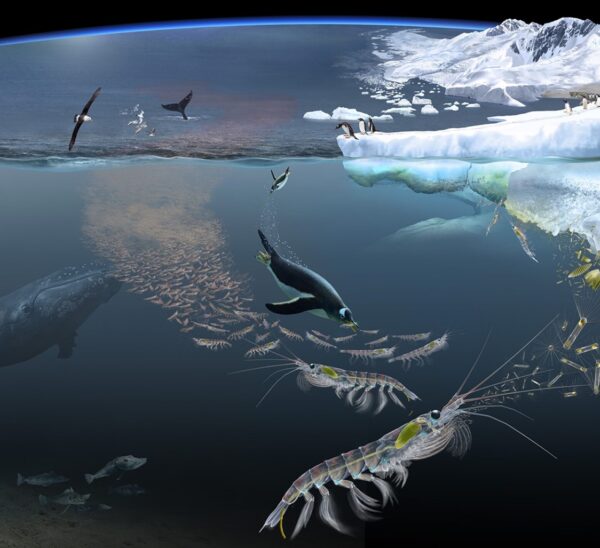Small marine crustaceans, like Antarctic krill, are as valuable as key coastal habitats for storing carbon and should be similarly protected, according to new research. The study reveals that krill store comparable amounts of carbon to ‘blue carbon’ habitats such as mangroves, saltmarshes, and seagrasses.
Lead author Dr. Emma Cavan from Imperial College London said, “…krill, and their poo, store similar amounts of carbon as some coastal marine plants.”
“I hope this means we can now work towards conserving krill and their valuable Southern Ocean ecosystem with the same gumption as we are seagrasses and mangroves.”
The study, published in Nature Communications, was led by Imperial College London and included researchers from the University of Exeter, UK Centre for Ecology & Hydrology, and the British Antarctic Survey.
Illustration of krill in the Southern Ocean ecosystem. Artist: Glynn Gorick, reproduced from Hill et al. 2024 (https://doi.org/10.3389/fmars.2024.1307402)
Co-author Dr. Simeon Hill from the British Antarctic Survey stated: “We benefit from its actions in removing carbon, but we also affect it through our actions which drive climate change.”
Serious Value
With swarms consisting up to 30 trillian individuals, krill lock at least 20 million tonnes of carbon annually into the deep ocean, valued between $4-46 billion. The study highlights krill’s role in storing carbon through their faecal pellets and shedding of their exoskeletons, with co-author Professor Angus Atkinson from Plymouth Marine Laboratory noting their “key role in storing carbon.”
The study also revealed that the depths that these waste products need to reach to remain stored away for at least 100 years were surprisingly shallow (average depth 381 metres), further enhancing their potential. In combination, these factors make the carbon storage from krill similar to that from coastal blue carbon plant stores.
As polar climate change impacts krill populations and expanding fisheries target them, researchers stress the importance of protecting both krill and their habitat to preserve this valuable carbon sink. The findings call for integrating carbon storage into conservation policies to meet climate goals.
Paper: ‘Valuing carbon sequestration by Antarctic krill faecal pellets’ by Cavan, E. L, Mackay, N., Hill, S.L., Atkinson, A., Belcher, A., & Visser, A is published in Nature Communications.
